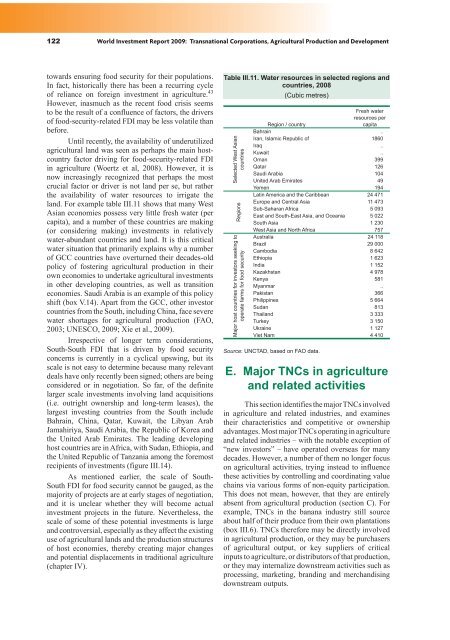World Investment Report 2009: Transnational Corporations - Unctad
World Investment Report 2009: Transnational Corporations - Unctad
World Investment Report 2009: Transnational Corporations - Unctad
You also want an ePaper? Increase the reach of your titles
YUMPU automatically turns print PDFs into web optimized ePapers that Google loves.
122 <strong>World</strong> <strong>Investment</strong> <strong>Report</strong> <strong>2009</strong>: <strong>Transnational</strong> <strong>Corporations</strong>, Agricultural Production and Development<br />
towards ensuring food security for their populations.<br />
In fact, historically there has been a recurring cycle<br />
of reliance on foreign investment in agriculture. 43<br />
However, inasmuch as the recent food crisis seems<br />
to be the result of a confluence of factors, the drivers<br />
of food-security-related FDI may be less volatile than<br />
before.<br />
Until recently, the availability of underutilized<br />
agricultural land was seen as perhaps the main hostcountry<br />
factor driving for food-security-related FDI<br />
in agriculture (Woertz et al, 2008). However, it is<br />
now increasingly recognized that perhaps the most<br />
crucial factor or driver is not land per se, but rather<br />
the availability of water resources to irrigate the<br />
land. For example table III.11 shows that many West<br />
Asian economies possess very little fresh water (per<br />
capita), and a number of these countries are making<br />
(or considering making) investments in relatively<br />
water-abundant countries and land. It is this critical<br />
water situation that primarily explains why a number<br />
of GCC countries have overturned their decades-old<br />
policy of fostering agricultural production in their<br />
own economies to undertake agricultural investments<br />
in other developing countries, as well as transition<br />
economies. Saudi Arabia is an example of this policy<br />
shift (box V.14). Apart from the GCC, other investor<br />
countries from the South, including China, face severe<br />
water shortages for agricultural production (FAO,<br />
2003; UNESCO, <strong>2009</strong>; Xie et al., <strong>2009</strong>).<br />
Irrespective of longer term considerations,<br />
South-South FDI that is driven by food security<br />
concerns is currently in a cyclical upswing, but its<br />
scale is not easy to determine because many relevant<br />
deals have only recently been signed; others are being<br />
considered or in negotiation. So far, of the definite<br />
larger scale investments involving land acquisitions<br />
(i.e. outright ownership and long-term leases), the<br />
largest investing countries from the South include<br />
Bahrain, China, Qatar, Kuwait, the Libyan Arab<br />
Jamahiriya, Saudi Arabia, the Republic of Korea and<br />
the United Arab Emirates. The leading developing<br />
host countries are in Africa, with Sudan, Ethiopia, and<br />
the United Republic of Tanzania among the foremost<br />
recipients of investments (figure III.14).<br />
As mentioned earlier, the scale of South-<br />
South FDI for food security cannot be gauged, as the<br />
majority of projects are at early stages of negotiation,<br />
and it is unclear whether they will become actual<br />
investment projects in the future. Nevertheless, the<br />
scale of some of these potential investments is large<br />
and controversial, especially as they affect the existing<br />
use of agricultural lands and the production structures<br />
of host economies, thereby creating major changes<br />
and potential displacements in traditional agriculture<br />
(chapter IV).<br />
Table III.11. Water resources in selected regions and<br />
countries, 2008<br />
(Cubic metres)<br />
Selected West Asian<br />
countries<br />
Regions<br />
Major host countries for investors seeking to<br />
operate farms for food security<br />
Region / country<br />
Fresh water<br />
resources per<br />
capita<br />
Bahrain ..<br />
Iran, Islamic Republic of 1860<br />
Iraq ..<br />
Kuwait ..<br />
Oman 399<br />
Qatar 126<br />
Saudi Arabia 104<br />
United Arab Emirates 49<br />
Yemen 194<br />
Latin America and the Caribbean 24 471<br />
Europe and Central Asia 11 473<br />
Sub-Saharan Africa 5 093<br />
East and South-East Asia, and Oceania 5 022<br />
South Asia 1 230<br />
West Asia and North Africa 757<br />
Australia 24 118<br />
Brazil 29 000<br />
Cambodia 8 642<br />
Ethiopia 1 623<br />
India 1 152<br />
Kazakhstan 4 978<br />
Kenya 581<br />
Myanmar ..<br />
Pakistan 366<br />
Philippines 5 664<br />
Sudan 813<br />
Thailand 3 333<br />
Turkey 3 150<br />
Ukraine 1 127<br />
Viet Nam 4 410<br />
Source: UNCTAD, based on FAO data.<br />
E. Major TNCs in agriculture<br />
and related activities<br />
This section identifies the major TNCs involved<br />
in agriculture and related industries, and examines<br />
their characteristics and competitive or ownership<br />
advantages. Most major TNCs operating in agriculture<br />
and related industries – with the notable exception of<br />
“new investors” – have operated overseas for many<br />
decades. However, a number of them no longer focus<br />
on agricultural activities, trying instead to influence<br />
these activities by controlling and coordinating value<br />
chains via various forms of non-equity participation.<br />
This does not mean, however, that they are entirely<br />
absent from agricultural production (section C). For<br />
example, TNCs in the banana industry still source<br />
about half of their produce from their own plantations<br />
(box III.6). TNCs therefore may be directly involved<br />
in agricultural production, or they may be purchasers<br />
of agricultural output, or key suppliers of critical<br />
inputs to agriculture, or distributors of that production,<br />
or they may internalize downstream activities such as<br />
processing, marketing, branding and merchandising<br />
downstream outputs.

















